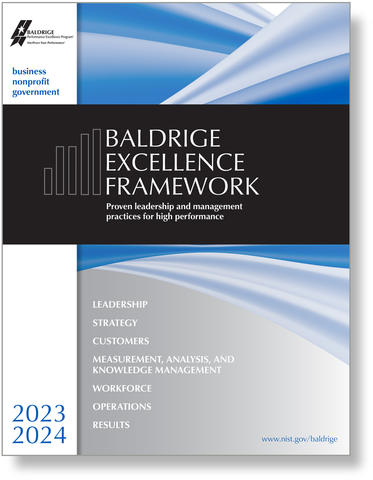Blogrige
The Official Baldrige Blog

I recently read an article on Forbes website by Michael Peregrine about lessons from this season's changes in baseball's pitch clock that apply to corporate leadership. I found the lessons parallel what the evolving Baldrige Excellence Framework® has been encouraging leaders of organizations to think about. Some of the lessons go back to the very beginnings of the Baldrige Program in 1987, and some mirror the changing environment reflected in newer or updated concepts in the Baldrige framework.
For those who are not followers of professional baseball, there were several rule changes this season. The most consequential is requiring pitchers and batters to "be ready" within 15-20 seconds after a prior pitch or play. The impact has been to significantly speed up a baseball game, typically making it a half hour shorter than games in recent seasons. Fans were bored, and something had to give if the sport was to thrive as a spectator sport.
I will review a few of the key lessons from Peregrine's article and then relate them to key attributes and behaviors of role model leaders.
The Lessons
1. Something had to give
Fans were bored with games that could last four hours. The leadership lesson was that leaders must gauge customer sentiment and be prepared to make significant change to meet customer expectations. Change is hard and risky, but leaders must face the need for change.
2. Tradition can stifle leaders
Baseball has been resistant to evolution. Part of its appeal was its sense of tradition. As Peregrine pointed out, the game Babe Ruth played is essentially the game played today. Leaders must be willing to confront the risk of complacency.
3. Change may be good
All indications this season are that games are being shortened by a significant amount of time and that spectators appreciate it. The leadership lesson is that leaders must be prepared to take intelligent risks. Change can lead to greater customer engagement and enhanced efficiency simultaneously.
4. Employees benefit from efficiency
Although players were skeptical at first, as they are becoming accustomed to the faster game, they are benefitting from greater alertness on the field, more attentiveness when batting, and more excitement when on base. The leadership lesson is that fears of putting time or other limits on meetings, length of memos, and other tasks might not be well-founded.
5. Remain flexible
A series of adjustments were made to some of the new rules after spring training season to respond to legitimate concerns. Leaders need to realize that we rarely get it perfect at first try and that admitting to the need to be adaptable and flexible is a sign of strength, not weakness.
6. Question strategy during execution
While early success is gratifying, continuing to monitor outcomes, both on the field and in the external environment (including customer and other stakeholder sentiment), is required. This includes the flexibility to modify strategy should circumstances require it. The leadership lesson is that strategy is rarely permanent, and action plans may need to change should circumstances warrant it. There could be unforeseen, unintended consequences when the strategy is first executed (for example, decreased advertising revenue with shorter games). Opportunities for further innovation may present themselves based on new research, customer input, or changes in the competitive environment.
Key Attributes of Role-Model Leaders
The Baldrige Program has observed the attributes and behaviors (attributes) of the leaders of role-model organizations for over 30 years. These attributes, much like the Baldrige Excellence Framework®, have evolved as the internal, external, and competitive environments have evolved. These attributes have been aligned with the 11 Baldrige Core Values. Some of the leadership attributes particularly relevant to Peregrine’s baseball lessons are as follows (with emphases added):
Visionary Leadership
- Guides the creation of strategies, systems, and methods to ensure ongoing organizational success
Systems Perspective
- Leads with recognition of a larger, interconnected ecosystem (partners, suppliers, customers, communities) in which the organization operates and has opportunities for innovation
Customer-Focused Excellence
- Builds a customer-focused culture and integrates customer engagement and loyalty as a strategic concept
- Creates a focus on anticipating changing and emerging customer and market requirements
Valuing People
- Builds partnerships with internal and external people and stakeholder groups
Agility and Resilience
- Develops a capacity for rapid change and for flexibility in operations
- Leads and inspires the organization to manage risk and make transformational changes despite ever-shorter cycle times
- Anticipates opportunities and threats and adapts strategy internally and through the organization’s business ecosystem
Focus on Success and Innovation
- Creates a focus on short- and longer-term factors that affect the organization and its future marketplace success, including managing uncertainty and risk and adjusting to a changing technological and economic environment
Management by Fact
- Challenges the organization to extract larger meaning from data and information to support improvement and innovation
Delivering Value and Results
- Defines and drives the organization to exceed stakeholder requirements and achieve value for all stakeholders
How about You?
Would your team have the intelligent risk-taking culture to add the pitch clock? Does your team observe and strategically address changing customer attitudes? When is the last time you considered and then pursued a transformational change? Maybe the time should be now. (A lot has changed in the last three years.)

Baldrige Excellence Framework®
The Baldrige Excellence Framework® has empowered organizations to accomplish their missions, improve results, and become more competitive. It includes the Criteria for Performance Excellence®, core values and concepts, and guidelines for evaluating your processes and results.
Purchase your copy today!
Available versions: Business/Nonprofit, Education, and Health Care






Very good column, Harry.
JVF